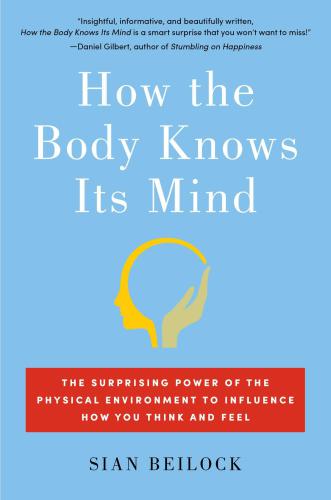
How the Body Knows Its Mind
The Surprising Power of the Physical Environment to Influence How You Think and Feel
کتاب های مرتبط
- اطلاعات
- نقد و بررسی
- دیدگاه کاربران
نقد و بررسی

September 22, 2014
Though the brain is the organ most commonly associated with thinking, psychologist Beilock (Choke) makes a fairly fresh case about the rest of the body’s
contribution to the process. The book
begins with the premise that the body’s interaction with its physical surroundings affects cognition, and Beilock goes on to show how the body can be used to manipulate everyday perceptions. She builds her argument with a variety of anecdotes and cultural references. Often these examples flip conventional wisdom to highlight the influence of our body on thought. For
example, she connects the correlation
between musical ability and IQ to finger dexterity. While her explanations are thought provoking, they rely on varying conceptions of the term “body,” weakening the central argument and making it hard to follow. It’s unlikely that readers will come away with a new understanding of cognition, but Beilock does offer an unconventional perspective that will, at the very least, stimulate the mind. Agent: Wendy Strothman, Strothman Agency.

October 15, 2014
Did you know that smiling invariably makes you feel better? Or that how you stand might affect your mood and the impression that you give to others? Our bodies are not passive partners to our brains. In fact, according to Beilock, our brains and our bodies often work in tandem, supporting each others' functions. If we learn to use those relationships, says the author, we might improve our lives and our interactions with others. Readable and informative, this fascinating account shows us what we can do to improve our ability to think and absorb information. For instance, if you have an important meeting or test, keeping your body in one position does not allow your mind to freely explore solutions or ideas, so pacing randomly may help you connect thoughts that might not normally go together. A lead researcher in a new area of cognitive science called "embodied cognitions," Beilock shares some of the most compelling and challenging cognitive research today. VERDICT A must-read for those who want to understand and embrace a greater connection between body and brain.--Rebecca Hill, Zionsville, IN
Copyright 2014 Library Journal, LLC Used with permission.

Starred review from December 1, 2014
After only a few pages into University of Chicago psychology professor Beilock's engaging book, readers will wonder why anyone would ever think that mind and body were separate. In order for infants to learn to walk, they must first think they can do it. And the mind only learns to guide the neophyte walker via the body actually doing the walking. So from then on, throughout the rest of her life, every time she even reads about walking, the walking nerve centers in her brain will light up as if she were actually walking. It may be hard to imagine that a book about the mind/body connection can be a page-turner, but Beilock reveals one intriguing secret after another unveiled by research on the workings of this incredible relationship. This system that can deal with depression by making one's face incapable of frowning, or sadness by taking an over-the-counter analgesic meant for a backache. The mind/body union allows hand gestures to aid memorization, boosts creativity with swimming or walking, and turns a physical response to anxiety into a mode for altering one's perspective. That Beilock is supercharged with enthusiasm about her topic is evident and infectious.(Reprinted with permission of Booklist, copyright 2014, American Library Association.)

























دیدگاه کاربران